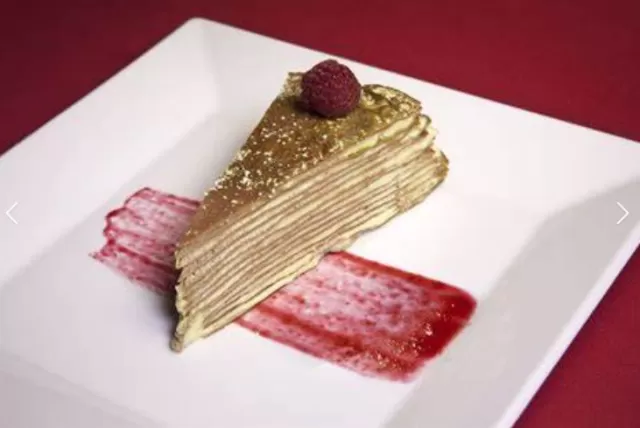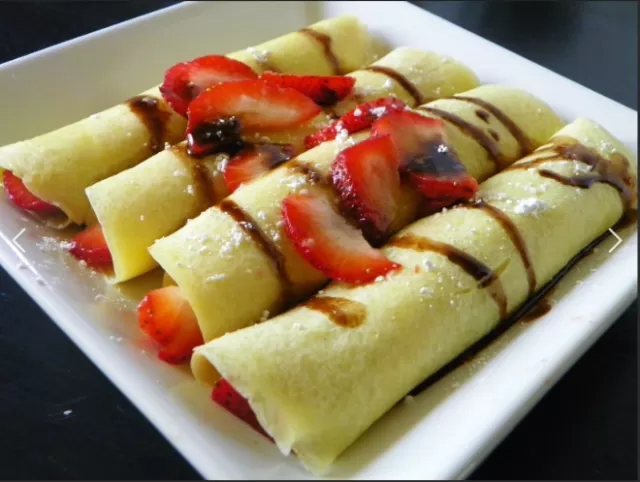Easy Crepes Recipe. Crepes, those delicate and delectable delights, stand as blank canvases eagerly awaiting the strokes of culinary creativity. With the power to transform from sweet to savory, these thin, elegant circles of perfection invite a Symphony of Flavors that knows no bounds.
In the realm of savory crepes, envision a world where the marriage of ham and cheese creates a savory symphony, where smoked salmon dances with crème fraîche in a harmonious duet, and where chicken or seafood bathes in a luxurious cream sauce, offering a taste of indulgence. Spinach and cheese, a classic pairing, add a touch of earthiness to the savory lineup, creating a palate-pleasing experience that leaves taste buds yearning for more.
On the sweet side, the possibilities are as limitless as the imagination. A hint of sugar in the batter lays the foundation for sweet crepes, while other options include the enchanting sprinkle of sugar with a drizzle of liqueur, a decadent spread of chocolate and nuts, or the fruity embrace of berries and ice cream. Each bite becomes a journey through a world of sweetness, textures, and delightful contrasts.
Indeed, the beauty of crepes lies in their adaptability, allowing chefs and home cooks alike to explore endless combinations. As culinary artists wield spatulas instead of brushes, crepes emerge not just as dishes but as edible masterpieces—infused with a medley of flavors and textures that celebrate the boundless possibilities within a simple, thin layer of batter.
A Culinary Delight: Exploring the Essence of Crepes

A crepe, a culinary masterpiece originating from the heart of French gastronomy, is a delectable dish crafted from a straightforward batter comprising flour, eggs, and milk.
Distinct from pancakes, crepes omit leavening agents such as baking powder or baking soda. This absence contributes to a batter of ethereal lightness, resulting in the creation of thin, delicate crepes that embody a culinary finesse.
Versatility defines the realm of crepes, as they can be enjoyed as standalone treats or utilized as wafer-thin envelopes to encase an array of savory or sweet fillings.
The culinary canvas that crepes provide is extensive—they grace tables during lunch or dinner, functioning as appetizers, main courses, and even decadent desserts.
The allure of crepes lies not only in their simple elegance but also in their ability to transform from savory to sweet with seamless grace.
Whether filled with savory delights or adorned with sweet indulgences, crepes represent a harmonious blend of simplicity and sophistication in French cuisine. As these thin delicacies grace the plate, they invite diners to savor a culinary experience that transcends traditional boundaries, making every bite a journey through the artistry of flavor and texture.
Artful Crepe Presentation: A Variety of Folds and Serving Styles
Embarking on a culinary journey with crepes unveils a world of creative possibilities, offering numerous ways to fold, roll, and serve these versatile delights—each method as diverse and enticing as the fillings they can embrace.
Simple Roll-Up: The most straightforward presentation involves spreading a light filling across the crepe and elegantly rolling it up, akin to a delicate cigarette.
This method allows the flavors to harmonize seamlessly, creating a delightful interplay of textures.
Burrito-style Roll: For heartier fillings, envision crepes as a canvas for a burrito-like creation.
Rolling the crepe around a substantial filling not only enhances the visual appeal but also ensures a satisfying and flavorful experience with every bite.
Triangle Fold: Folding a crepe in half and then once more creates an elegant triangle.
This presentation is particularly popular for flambé crepes and the classic Crepes Suzette, showcasing a symmetrical form that adds a touch of sophistication to the dining experience.
Pannequet (Rectangular Fold): The French term “pannequet” refers to a neatly folded crepe that forms a rectangle, encasing the filling within.
This method combines precision with aesthetics, presenting a well-defined package that showcases both the crepe and its delightful contents.
Crepes Cake: Going beyond traditional folds, layering multiple crepes with a filling—instead of folding—results in a spectacular crepe cake.
This assembly creates a visually stunning and indulgent treat, where each layer contributes to the overall symphony of flavors.
The art of folding and serving crepes is limited only by imagination, making them a versatile canvas for culinary creativity.
Whether enjoyed as a simple roll, a folded triangle, or as part of an elaborate crepe cake, these delicate creations invite a world of possibilities that elevate the dining experience to new heights.
Classic Crepe Creation: A Symphony of Ingredients

Delve into the art of crafting delectable crepes with this harmonious ensemble of ingredients, each contributing to the creation of a thin, delicate masterpiece.
Gather these elements to embark on a culinary journey:.
Unbleached All-Purpose Flour (1 cup): The foundation of your crepe batter, providing structure and a neutral base to showcase the flavors that unfold with each delicate bite.
Granulated Sugar (1 tablespoon): A hint of sweetness to balance and enhance the overall taste profile of the crepes, ensuring a subtle sweetness that complements various fillings.
Kosher Salt (¼ teaspoon): A pinch of salt to elevate and balance the flavors, enhancing the savory or sweet notes of the crepes.
Whole Milk (1 ½ cups, room temperature): The liquid essence that brings a creamy texture to the batter, contributing to the tender and thin nature of the crepes.
Large Eggs (4, room temperature): The binding agent that adds richness, structure, and a velvety texture to the crepe batter, ensuring a cohesive and delightful result.
Unsalted Butter (3 tablespoons, melted): A luscious addition that imparts a buttery richness to the batter, enhancing both flavor and texture.
Additionally, more butter is reserved for brushing during the cooking process, adding a golden finish to the crepes.
Embark on the crepe-making adventure by blending these ingredients into a seamless batter, transforming them into the delicate canvases for an array of fillings.
With precision and creativity, these simple components converge to create a culinary experience that celebrates the artistry of French cuisine.
Crafting Perfect Crepes: A Step-by-Step Culinary Ballet
Embark on a culinary journey to create exquisite crepes with this Step-by-Step Guide, transforming simple ingredients into thin, delicate masterpieces.
Create Crepe Batter:.
In a blender, combine 1 cup unbleached all-purpose flour, 1 tablespoon granulated sugar, ¼ teaspoon kosher salt, 1 ½ cups whole milk (at room temperature), 4 large eggs (at room temperature), and 3 tablespoons melted unsalted butter.
Puree the ingredients until smooth, approximately 30 seconds.
Refrigerate the batter for at least 30 minutes or up to 1 day.
Before using, give it a quick stir to ensure consistency.
Prep Pan and Add Batter:.
Heat an 8-inch nonstick skillet over medium heat.
Lightly coat the skillet with butter.
Quickly pour 1/4 cup of the batter into the center of the skillet, tilting and swirling the pan to ensure an even coating of the batter on the bottom.
Cook Crepe and Flip:.
Cook until the crepe turns golden in places on the bottom, and the edges begin to lift from the pan (approximately 1 to 1 1/2 minutes).
Use an offset spatula to gently lift one edge of the crepe, then use your fingers to gracefully flip it.
Finish Cooking Crepe:.
Cook the crepe on the second side until just set and golden in places on the bottom, taking about 45 seconds.
Slide the cooked crepe onto a plate lined with paper towels.
Repeat to Cook More Crepes:.
Repeat the process with the remaining batter, ensuring to coat the pan with more butter as needed.
Stack the cooked crepes directly on top of one another.
Let Crepes Cool:.
Allow the stack of crepes to cool to room temperature before incorporating them into your desired culinary creations.
With this detailed guide, you’re poised to master the art of crepe-making, creating a symphony of flavors and textures that will delight the palate and elevate your culinary repertoire.
Preserving Crepe Perfection: Storage Tips for Leftover Crepes

Maximize the lifespan of your delectable crepes by employing proper storage techniques.
Whether you plan to enjoy them in the coming days or save them for later use, here’s how to store leftover crepes:.
In the Refrigerator:.
Stack and Cool: Allow the cooked crepes to cool completely.
Layer with Wax Paper: Stack the cooled crepes with layers of wax paper in between each to prevent sticking.
Wrap Securely: Wrap the stack in plastic wrap, ensuring a tight seal to maintain freshness.
Refrigerate: Place the wrapped crepes in the refrigerator, where they can be stored for up to three days.
In the Freezer:.
Wrap Each Crepe Individually: Wrap each crepe individually in plastic wrap.
Securely Seal: Ensure that each crepe is securely sealed to prevent freezer burn.
Group for Efficiency: Place the individually wrapped crepes in a larger freezer-safe bag for added protection.
Label and Date: Consider labeling the bag with the date to keep track of freshness.
Freeze: Store the wrapped crepes in the freezer, where they can maintain their quality for up to one month.
When ready to enjoy your stored crepes, simply thaw them in the refrigerator or at room temperature.
Reheat gently in a skillet or microwave, and you’ll be savoring the deliciousness of your homemade crepes once again. These storage methods ensure that your culinary creations remain a convenient and delightful option whenever the craving for crepes strikes.
*The information is for reference only.